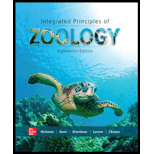
The arthropod exoskeleton is the most complex of invertebrate integuments. Describe its structure, and explain the difference in the way cuticle is hardened in crustaceans and in insects.
To describe: The structure of arthropod exoskeleton.
Introduction: Integument is considered as an outer covering of the body and it is the protective layer such as the skin and all the structures associated with or originated from the skin, for example, scales, hair, horns, feathers, and setae. The most complex invertebrate integuments possessed by the arthropods.
Explanation of Solution
Structure of the arthropod exoskeleton:
The arthropod exoskeleton comprised of a single-layered epidermis, also known as hypodermis, which secretes two different zones of cuticles. This includes procuticle and epicuticle. The procuticle is a thicker inner zone and it is made up of protein and chitin deposited in layers. Epicuticle is the thin, outer zone of the cuticle and it is lying on the outer surface above the procuticle. The epicuticle is considered as a nonchitinous complex of proteins as well as lipids that confer a protective moisture-proofing barrier to the integument.
To explain: The difference in the way cuticle is hardened in crustaceans and in insects.
Explanation of Solution
The difference in the way cuticle is hardened in crustaceans and in insects:
The cuticle of an arthropod may be a tough however flexible and soft layer, as it is in numerous microcrustaceans and insect larvae or it may be hardened in one of two ways. The cuticle in decapod crustaceans, such as lobsters, and crabs, is stiffened by calcification process.
In insects, the hardening takes place once the molecules of proteins join together with stabilizing cross-linkages within and between the adjacent lamellae of the procuticle. Sclerotization is the result of this process. Sclerotization is a process in which the formation of a highly resistant as well as insoluble protein known as sclerotin occurs.
Want to see more full solutions like this?
Chapter 29 Solutions
Loose Leaf For Integrated Principles Of Zoology
- The vertebrate skin has various functions like protection, temperature regulation, elimination of waste, water conservation, radiation protection, vitamin synthesis and environmental responsiveness. Discuss and elaborate how these functions relate to the structure of a vertebral integument. Provide at least two specific examples.arrow_forwardGive a broad conclusion about the integumentary system of humans and frogs and their importance.arrow_forwardAside from skin (an organ), what other structures are in the integumentary system of other animals and what are their functions?arrow_forward
- The vertebrate skin has various functions like protection, temperature regulation, elimination of waste, water conservation, radiation protection, vitamin synthesis and environmental responsiveness. Elucidate how these functions relate to the structure of a vertebral integument. Provide at least three specific examples.arrow_forwardBony box in turtles are covered by epidermal keratinized scales calledarrow_forwardSkeletons consist of three types of connective tissue:________,________ , and______ . All consist of cells embedded in a matrix of_____ protein and other extracellular components, such as glycoproteins or calcium phosphate.arrow_forward
- Which is FALSE about integuments? A. Turtles have epidermal scales over the top of their shells B. Amphibians do gas exchange through their skin C. Reptile scales form a continuous water tight sheath D. The main function of fish slime is to keep salt from entering their bodies E. Bony Fish have a layer of epidermis over the top of their scalesarrow_forwardExplain the functions of the integumentary system in fish.arrow_forwardWhich statement about integument tissues is NOT TRUE? Group of answer choices A. Turtle skin is actually under their shell B. Dermal layers are mostly comprised of connective tissue of various kinds C. arthropod cuticles are noncellular secretions D. feathers and hairs are made of cells E. Epidermal layers are an example of epithelial tissuearrow_forward
- Describe the bending of cilium. what is the importance of the fact that the cilium does not merely move back and forth.arrow_forwardEXPLAIN/ ELABORATE ON THE DIAGRAM BELOW ON THE PHYLOGENY OF THE INTEGUMENTARY SYSTEM IN VERTEBRATES IN NOT MORE THAN 15 SENTENCES.arrow_forwardThe arthropod exoskeleton is the most complex of invertebrate in-teguments. Describe its structure, and explain the difference in the way cuticle is hardened in crustaceans and in insectsarrow_forward
 Human Anatomy & Physiology (11th Edition)BiologyISBN:9780134580999Author:Elaine N. Marieb, Katja N. HoehnPublisher:PEARSON
Human Anatomy & Physiology (11th Edition)BiologyISBN:9780134580999Author:Elaine N. Marieb, Katja N. HoehnPublisher:PEARSON Biology 2eBiologyISBN:9781947172517Author:Matthew Douglas, Jung Choi, Mary Ann ClarkPublisher:OpenStax
Biology 2eBiologyISBN:9781947172517Author:Matthew Douglas, Jung Choi, Mary Ann ClarkPublisher:OpenStax Anatomy & PhysiologyBiologyISBN:9781259398629Author:McKinley, Michael P., O'loughlin, Valerie Dean, Bidle, Theresa StouterPublisher:Mcgraw Hill Education,
Anatomy & PhysiologyBiologyISBN:9781259398629Author:McKinley, Michael P., O'loughlin, Valerie Dean, Bidle, Theresa StouterPublisher:Mcgraw Hill Education, Molecular Biology of the Cell (Sixth Edition)BiologyISBN:9780815344322Author:Bruce Alberts, Alexander D. Johnson, Julian Lewis, David Morgan, Martin Raff, Keith Roberts, Peter WalterPublisher:W. W. Norton & Company
Molecular Biology of the Cell (Sixth Edition)BiologyISBN:9780815344322Author:Bruce Alberts, Alexander D. Johnson, Julian Lewis, David Morgan, Martin Raff, Keith Roberts, Peter WalterPublisher:W. W. Norton & Company Laboratory Manual For Human Anatomy & PhysiologyBiologyISBN:9781260159363Author:Martin, Terry R., Prentice-craver, CynthiaPublisher:McGraw-Hill Publishing Co.
Laboratory Manual For Human Anatomy & PhysiologyBiologyISBN:9781260159363Author:Martin, Terry R., Prentice-craver, CynthiaPublisher:McGraw-Hill Publishing Co. Inquiry Into Life (16th Edition)BiologyISBN:9781260231700Author:Sylvia S. Mader, Michael WindelspechtPublisher:McGraw Hill Education
Inquiry Into Life (16th Edition)BiologyISBN:9781260231700Author:Sylvia S. Mader, Michael WindelspechtPublisher:McGraw Hill Education





